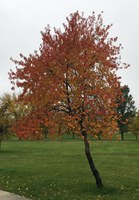Dakota Gardener: Seeing red
(Click an image below to view a high-resolution image that can be downloaded)
By Joe Zeleznik, Forester
NDSU Extension
If someone is “seeing red,” it means that they suddenly became very angry. It’s a description of a very strong negative emotion.
On the other hand, people often would love to see red in their trees, at least during autumn. A typical discussion about fall tree color in North Dakota usually starts with, “Do we have red trees in North Dakota? I thought everything just turned yellow.”
Admittedly, there’s definitely a lot of yellow in the fall landscape. Most of our native deciduous trees turn yellow. Cottonwood, paper birch, boxelder, green ash, hackberry. They’re all yellow. Bur oak and American linden as well.
Is there any red in the landscape? Or do we have to drive all the way into Minnesota to see the oranges and reds coming from the maple trees?
We actually do get a lot of red in the fall landscape, if you know where to look. Mostly, you have to look in the understory.
The three native viburnums – American cranberrybush, arrowwood and nannyberry – all turn red in the fall. The cranberrybush leaves are especially striking, closer to a fire-engine red. Nannyberry is pretty close, though with a hint of purple. Arrowwood is often more a burgundy color.
Don’t forgot the chokecherries and the plums. Again, the brilliant, blazing red color lights up the edge of the forest, or perhaps just those small pockets of forest in the broader prairie landscape. The woody draws of western North Dakota are sometimes dominated by plums and can catch your eye in the fall.
You don’t have to drive all the way to the northern forests of Minnesota to see beautiful red fall colors. Travel to the forests that are nearer to home. Look closely, and you’ll be pleasantly surprised.
Here’s another one. Check out patches of smooth sumac. This shrub spreads from rhizomes, creating thickets along ditches and in other highly-disturbed soils. The fall color varies from burgundy to fire-engine red. The huge compound leaves are great for kids’ art projects.
And don’t forget woodbine – a vine that’s the western cousin of Virginia creeper. This plant grows up trees and fences with ease, and may sometimes become a bit of a nuisance. Nevertheless, in autumn, its five leaflets turn a beautiful bright red which can be seen from ground line all the way to the top of tall trees. When the vine’s in an evergreen tree, the color contrast is fantastic.
Do you remember the lessons from grade school art class, regarding primary colors? Red, yellow and blue can be combined to produce all of the other colors. Of course, there are no blue leaved-trees. However, do we see any purples or violets in the fall palette, between blue and red? How about oranges, between red and yellow?
Those colors are harder to come by. Sometimes, red-osier dogwood leaves turn purple, though many plants are more reddish.
Orange is a difficult color to find in North Dakota in the fall. That’s when I look to the ornamentals, like Ohio buckeye or Manchurian apricot. In the right season, they’re very impressive.
I encourage you to go out and see red. It’s actually a really good thing.
----
NDSU Agriculture Communication – Sept. 19, 2023
Source: Joe Zeleznik, 701-730-3389, joseph.zeleznik@ndsu.edu
Editor: Kelli Anderson, 701-231-7881, kelli.c.anderson@ndsu.edu




